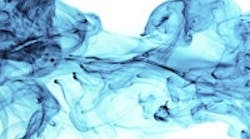THREE-PHASE SEPARATOR
Figure 1. A design with over- and under-baffles can separate liquid phases that have similar rates.
It's good practice to have the mixed feed enter through some type of stilling well. This minimizes mixing in the liquid separation volume of the vessel.Good separator design requires sufficient:• cross-sectional area for vapor flow above the liquids to allow for the liquid to drop out of the vapor before reaching the under-baffle (the drops must fall fast enough and adequate time must be provided so mixed liquid in the feed doesn't fall into the segregated heavy phase);• retention time for liquid level control in the heavy liquid and light liquid product;• residence time in the liquid separation area for phase separation;• cross-sectional area in the phase separation zone so the dropping heavy liquid has a lower velocity than the rising heavy liquid;• escape area from the stilling well to prevent liquid re-entrainment by the vapor;• under-baffle penetration in the liquid to stop the light liquid from getting to the heavy liquid overflow; and• low velocity below the under-baffle to prevent entrainment of light liquid.The geometric layout must balance these criteria to get a drum that will operate successfully. Many literature references go into the details. Here, we'll concentrate on the liquid separation volume.The baffle heights set the retention times between the light liquid and the heavy liquid. The pressures generated by the liquid height on each side of the under-baffle must balance. The height of the liquid/liquid interface on the left side of the under-baffle adjusts based on the liquid densities.The liquid/liquid interface sets the volume between the light liquid overflow weir and the heavy liquid. This is the liquid separation volume available. The liquid/liquid density difference controls the ease of separation.Assuming the light liquid layer is completely light liquid, Equation 1 summarizes the required pressure balance:
ρL × HL + ρH (HLLB - HL) = ρH × HHLB (1)where
ρL is the density of the light liquid,
HL is the height of the light liquid (depth of separation layer),
ρH is the density of the heavy liquid,
HLLB is the height of the light liquid overflow baffle, and
HHLB is the height of the heavy liquid overflow baffle.The two over-baffles must be different heights to allow a liquid separation zone to form. Equation 2 defines the baffle cut,
BC, as the difference between the heights of the overflow baffles:
BC = HLLB - HHLB (2)Rearranging, we get the liquid separation zone depth (or light liquid layer height) as a function of the baffle cut and densities:
HL = BC/[1 – (ρL/ρH)] (3)Equation 3 illustrates a key point — as the densities get closer, the separation layer gets deeper for a given baffle cut. This is good. As the densities get closer, more separation time is required. The over- and under-baffle configuration tends to automatically compensate for a reasonable variation in densities during operation.The maximum possible height under the baffle, H
UDmax, also can be determined:
HUDmax = HLLB - HL (4)As the liquid layer required for separation increases, the lower edge of the under-baffle must be deeper into the liquid. The upper liquid layer must stay completely on the left side of the under-baffle.So far, we've assumed the light and heavy liquids separate immediately. That's obviously not true. In operation, the upper liquid layer has a higher density than that of the light liquid. Therefore, safety margins must be added to the baffle heights to ensure the drum operates properly.Standard design practices address this issue. However, some special cases require a more fundamental approach that uses separation flux in the upper liquid layer along with an average residence time generated from Stokes' law to estimate an expected operating density.
ANDREW SLOLEY is a Chemical Processing contributing editor. You can e-mail him at [email protected]


